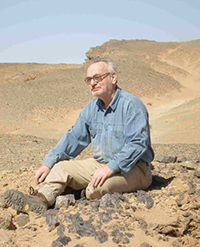 Bernard Mottequin. Royal Belgian Institute of Natural Sciences, Operational Directorate Earth and History of Life, rue Vautier 29, B 1000 Brussels, Belgium. bmottequin@naturalsciences.be
Bernard Mottequin. Royal Belgian Institute of Natural Sciences, Operational Directorate Earth and History of Life, rue Vautier 29, B 1000 Brussels, Belgium. bmottequin@naturalsciences.be
Bernard Mottequin is a palaeontologist with a special interest in Devonian and Mississippian brachiopods (e.g., taxonomy, palaeoecology), especially those from Western Europe and North Africa, and their applications. After his PhD in sciences at the University of Liège (ULg) and the Royal Belgian Institute of Natural Sciences (RBINS, Brussels), he was postdoctoral research fellow in palaeontology at the University of Dublin, and then research assistant and honorary lecturer at the ULg, mainly involved in the modernization programme of the Geological map of southern Belgium. He is currently researcher at the RBINS.

 Konrad Bartzsch. Stauffenberg-Strasse 68, D-07318 Saalfeld, Germany.
Konrad Bartzsch. Stauffenberg-Strasse 68, D-07318 Saalfeld, Germany.
Konrad Bartzsch is a geologist working in Thuringia up to retiring (1999) in the fields of mining (iron, baryte, fluorite), and engineering (clay, sand, stones). Besides, he always was interested in biostratigraphy and fossils (trilobites, ammonoids, brachiopods, ostracods, conodonts), since his childhood systematically collecting in the Devonian and Lower Carboniferous of the Thuringian Slate Mountains. There he was and is still cooperating with the Technical University (Mining Academy) Freiberg, the Senckenberg Museum Dresden, the Natural History Museum Berlin, and the Geo-Research Institute Potsdam, as an active member of the German subcommissions for Devonian and Carboniferous Stratigraphy.

 Eric Simon. Royal Belgian Institute of Natural Sciences, Operational Directorate Earth and History of Life, rue Vautier 29, B 1000 Brussels, Belgium. (Deceased on 11 February 2018)
Eric Simon. Royal Belgian Institute of Natural Sciences, Operational Directorate Earth and History of Life, rue Vautier 29, B 1000 Brussels, Belgium. (Deceased on 11 February 2018)
Eric Simon made his studies and Ph.D. thesis (Biology) at the Free University of Brussels. His works concern the study of fossils and extant brachiopod species. They deal with ontogeny, evolution, ecology and palaeo-ecology, morphological analyses and taxonomic problems. Improving the perception of biological characteristics in the field of paleontology is for him an important concern. He passed away suddenly on 11 February 2018.

 Dieter Weyer. Museum of Natural History (Leibniz Institute) at Humboldt University, Invalidenstrasse 43, D-10115, Berlin, Germany. dieter.weyer@t-online.de
Dieter Weyer. Museum of Natural History (Leibniz Institute) at Humboldt University, Invalidenstrasse 43, D-10115, Berlin, Germany. dieter.weyer@t-online.de
Dieter Weyer is a palaeontologist for Palaeozoic times, having studied mainly ammonoids, corals, bivalves, brachiopods and conodonts for taxonomic and biostratigraphic purposes. His main field are Ordovician-Permian corals and their phylogeny. As diplom geologist, he worked 1960-1978 in Berlin at the Geological Survey of the then East German State (custodian of the palaeontological collections of the former Prussian Geological Survey, biostratigraphy of Carboniferous and Devonian oil boreholes in northeastern Germany). His PhD in sciences was absolved in 1973 at Humboldt University in Berlin. From 1979-2000, he changed as geologist/palaeontologist to the Museum of Natural History in Magdeburg. After pensioning, he is up to now honorary member of the staff in the Museum of Natural History, Berlin. There he continues his coral studies (mainly from Germany, Morocco, Russia, Czech Republic, Norway, Australia), partly cooperating with specialists in Russia, Poland, and Australia.

